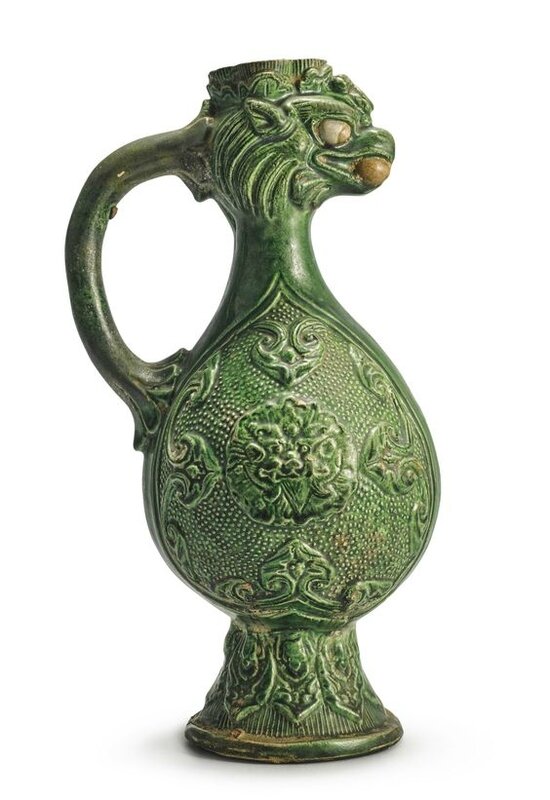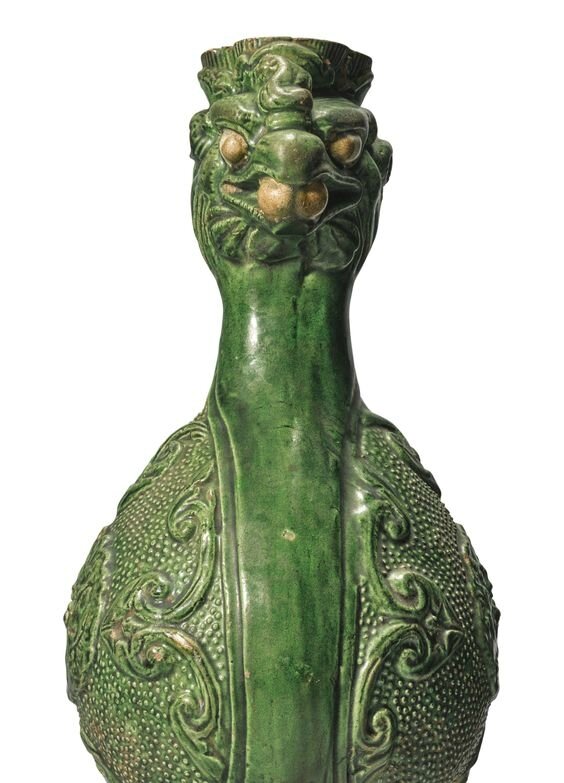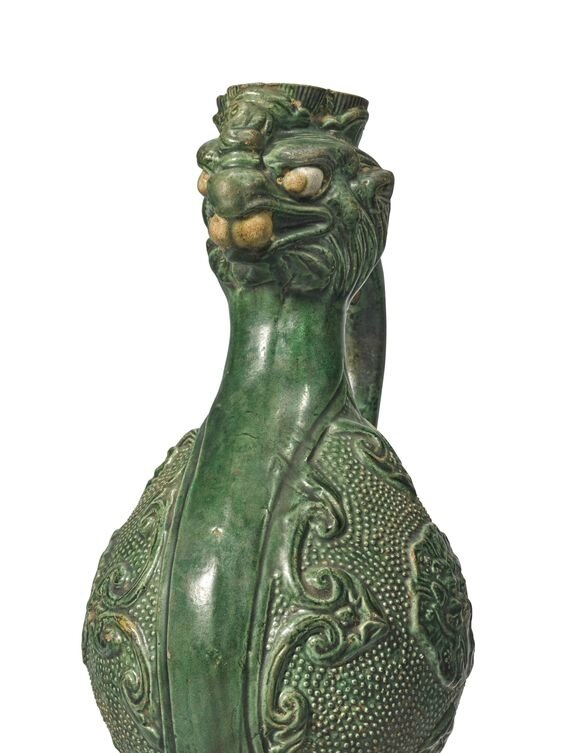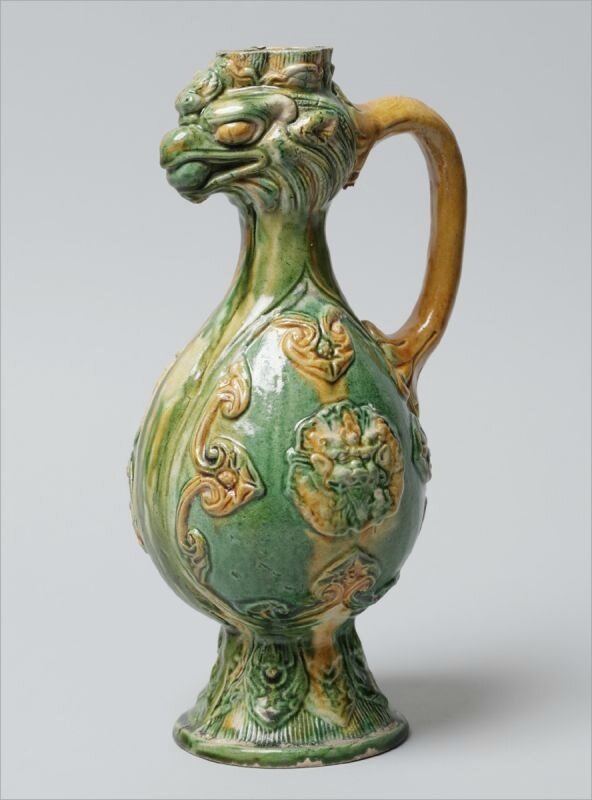An exceptionally rare green-glazed phoenix-head pottery ewer, Tang dynasty (618-907)
Lot 75. An exceptionally rare green-glazed phoenix-head pottery ewer, Tang dynasty (618-907). Height 10 7/8 in., 27.7 cm. Estimate 80,000 — 120,000 USD. Lot Sold 187,500 USD. Photo: Sotheby's.
the flattened pear-shaped body supported on a high splayed foot and rising to a slender waisted neck surmounted by a fierce phoenix head clasping a pearl in its beak, its crest opening to form the quatrefoil mouth, a loop handle stretching from the shoulder to the back of the phoenix's head, the vessel crisply molded with bands of overlapping lappets and radiating vertical ribs at the foot, with teardrop-form panels to each side of the body, each centered with an applied lion mask on a stippled ground framed by four ruyi-shaped motifs, applied overall with a vibrant green glaze, except for the eyes and pearl, applied with straw and cream glazes, Japanese wood box (3)
Literature: Sekai Toji Zenshu 9 Zui To Hen / Collection of World's Ceramics, vol. 9, Tokyo, 1961, pl. 80.
Note: This piece is an extremely rare and outstanding example of phoenix-head ewers that were inspired by Sassanian metal examples and adapted to suit Chinese taste. The form and molded relief decoration follow metal wares of the Middle East, while the phoenix-head and ruyi-shaped panel bordered by further ruyi heads remain firmly rooted in Chinese tradition. Thus, it embodies the commercial and cultural exchange that characterizes the art of the early Tang dynasty.
Phoenix-head ewers molded with applied masks against a stippled ground, which are reminiscent of granulated metalwork, are rare and those covered almost entirely in a monochrome green glaze are even rarer. A sancai ewer of this design and with a stippled ground, sold in our London rooms, 7th December 1993, lot 139; one lacking the stipples from the Hakone Art Museum, Hakone, is illustrated in Mayuyama: Seventy Years, Tokyo, 1976, vol. 1, pl. 233; another is published in Hirano Tatsuo, Kotoken Senka, Osaka, 1988, pl. 40; a fourth, from the George Eumorfopoulos collection, now in the British Museum, London, is illustrated in R.L. Hobson, The Eumorfopoulos Collection, vol. 1, London, 1925, col. pl. L, fig. 389; and a further ewer sold in our London rooms, 7th November 1993, lot 139. See also a sancai ewer of this type, but molded on the central panels with flower heads, in the Shaanxi Provincial Museum, Xi’an, illustrated in Out of China’s Earth: Archaeological Discoveries in the People’s Republic of China, London, 1981, pl. 244; and another with a stippled ground, in the Gansu Provincial Museum, Lanzhou, published in Zhongguo wenwu jinghua Daquan. Taozi juan [The quintessence of Chinese cultural relics. Ceramics], Hong Kong, 1993, p. 126, pl. 440.
Margaret Medley in Metalwork and Chinese Ceramics, London, 1972 (p. 4), discusses the far-reaching effect on Tang potters of the opening of diplomatic relations between the Chinese Emperor Yangdi of the Sui dynasty and the Sassanian Persian Empire (224-651), which led to the exchange of tributary gifts as well as the arrival of Persian craftsmen at the Imperial court in the Tang capital Chang’an (today’s Xi’an, Shaanxi).
Sotheby's. Important Chinese Art, New York, 13 Sep 2017, 10:00 AM
NDB: Another phoenix-head ewer is actually on show at Mayuyama & Co. Ltd., Tokyo, 'An Exhibition of the Arts of the TANG DYNASTY'.
Sancai Phoenix-head Ewer, Tang dynasty (7-8th century). H 28 cm © 2017 MAYUYAMA & CO., LTD.

/https%3A%2F%2Fprofilepics.canalblog.com%2Fprofilepics%2F1%2F0%2F100183.jpg)
/https%3A%2F%2Fstorage.canalblog.com%2F03%2F02%2F119589%2F96711876_o.jpg)
/https%3A%2F%2Fstorage.canalblog.com%2F11%2F31%2F119589%2F94773502_o.jpg)
/https%3A%2F%2Fstorage.canalblog.com%2F20%2F83%2F119589%2F94772815_o.jpg)
/https%3A%2F%2Fstorage.canalblog.com%2F26%2F72%2F119589%2F75604929_o.jpg)
/https%3A%2F%2Fstorage.canalblog.com%2F59%2F60%2F119589%2F26458628_o.jpg)








/http%3A%2F%2Fstorage.canalblog.com%2F69%2F19%2F119589%2F129546631_o.jpg)
/http%3A%2F%2Fstorage.canalblog.com%2F16%2F17%2F119589%2F129318246_o.jpg)
/http%3A%2F%2Fstorage.canalblog.com%2F18%2F75%2F119589%2F129318212_o.jpg)
/http%3A%2F%2Fstorage.canalblog.com%2F77%2F40%2F119589%2F127987826_o.jpg)